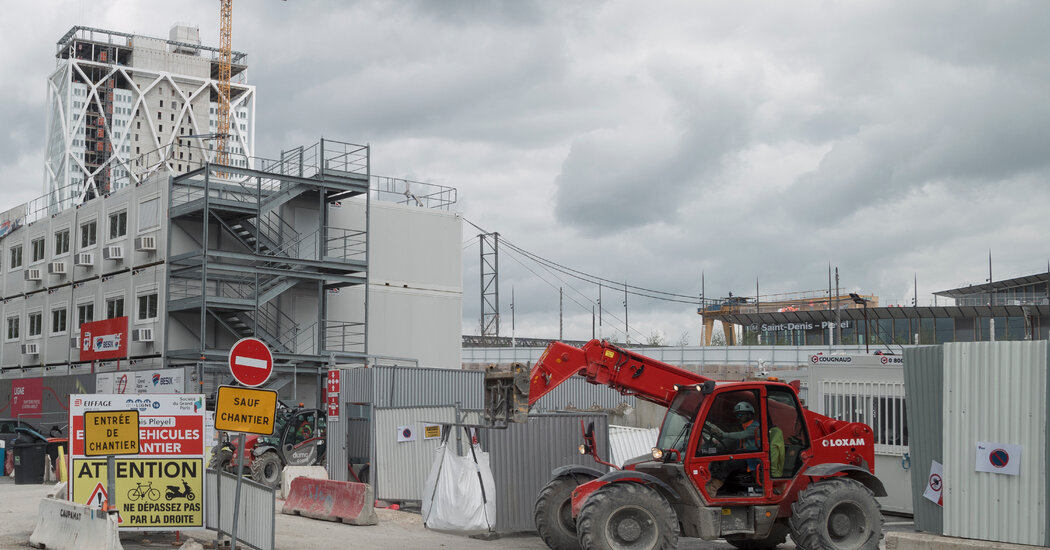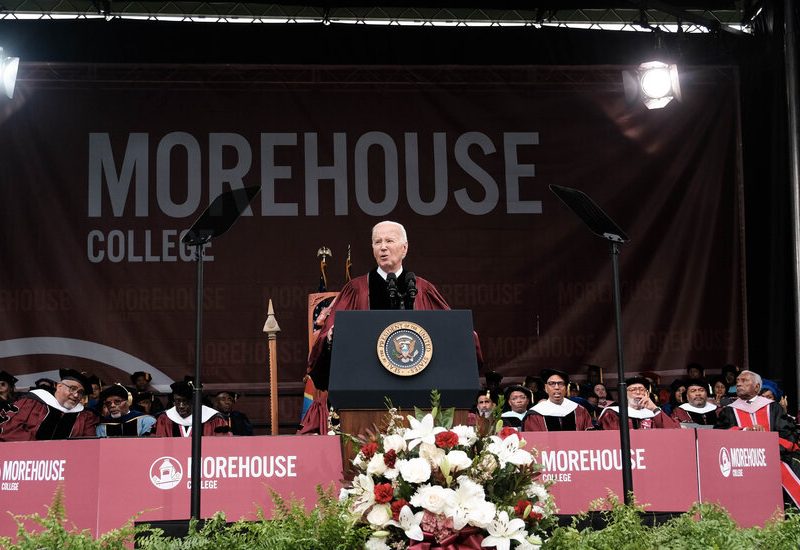France’s president, Emmanuel Macron, promised to build the Summer Olympics safely, free of the construction hazards and migrant worker abuses that tarnished soccer’s 2022 World Cup in Qatar.
Months before the Games begin in Paris, he declared success.
“We are living up to the commitments we made,” Mr. Macron said in February.
Government data shows fewer than 200 injuries at Olympics sites over a four-year construction blitz. And no deaths.
But inspection records and other documents show that Olympics sites have been more dangerous than organizers have let on, with some projects failing to meet basic safety standards. When undocumented immigrants are hurt on the job, workers and officials say, the injuries are often handled off the books, all but guaranteeing that they will not show up in government statistics.
Even fatal accidents of laborers working legally are sometimes omitted from the Olympic count.
When two workers died on a subway project that Mr. Macron’s former transportation minister called “the lifeline of the Olympics,” their deaths were not included in the Olympic total.
When a truck fatally crushed a man who was helping build a wastewater basin to allow swimming events to be held in the Seine, his death was omitted from the Olympic count. “Administratively, it was put in another category,” said Paul Duphil, the executive secretary of France’s quasi-government construction safety watchdog.
That is because of how the French government defines an Olympic site. Accidents at the Olympic Village count, but not at the Pleyel Tower, a nearby skyscraper that has been transformed into a luxury hotel for the Games. Work at the media center counts, but construction of a gigantic footbridge that the local government says is “at the heart of the Olympic project” does not.
And in an industry where some injuries are all but inevitable, France’s data is at times remarkably pristine: The city of Marseille told The New York Times that there had not been even a single minor injury during two years of dredging and construction of the Olympic Marina, a facility on the Mediterranean where sailing competitions will be held.
Workers, union officials and some labor inspectors say all of this is part of Mr. Macron’s effort to make France sparkle in the Olympic spotlight. “It allows them to say that France isn’t Qatar,” said Simon Picou, a union representative for government labor inspectors.
Documents, along with interviews with government officials, inspectors and more than a dozen workers, show that undocumented immigrants played a larger and riskier role in delivering the Olympics than the Macron administration acknowledges. Undocumented workers described being pushed to do dangerous jobs for long hours without safety glasses, harnesses or other gear.
The situation is especially sensitive for Mr. Macron because he is under pressure to crack down on illegal immigration. And the Olympics arrive after years of changes to French labor laws. Mr. Macron cut funding for inspections and abolished company safety boards. The changes were meant to simplify France’s stifling bureaucracy. Union leaders and labor inspectors say they have made work more dangerous.
There is no indication that France has seen anywhere near as many injuries as Qatar, where journalists revealed deadly working conditions in the run-up to the 2022 World Cup and the government acknowledges that dozens of migrant workers died. But Mr. Macron has campaigned on delivering an Olympics that will be as safe and humane as they are majestic. He has required unions and employers to promise that they will maintain safe working conditions.
Mr. Macron’s office referred questions about working conditions and the injury count to other agencies. Antoine du Souich, the strategy director of Solideo, the government body that released the injury figures, said in an interview that he was unaware of any accidents involving undocumented workers. The agency relies on injury reports from construction companies, which can face legal repercussions if they are found to employ undocumented workers. And France’s official workplace injury figures include, by rule, only legal workers.
In interviews, undocumented workers described being encouraged by their employer not to report their injuries or see doctors. Mr. Picou said that employers sometimes fire injured workers or pay them to keep quiet.
Mr. du Souich said that he believes that undocumented work on Olympic sites was rare. Inspectors have identified about 150 cases, he said. “We think that the level of control that was put in place made it possible to identify — never all the cases, undoubtedly — but we think practically all the cases.”
But many of those undocumented workers came forward voluntarily, with the help of unions, in hopes of earning legal status. Inspectors have increased enforcement at Olympic sites, but that has amounted to checking the work authorization of only about 1,000 of the roughly 30,000 workers. And those without papers say they have plenty of time to hide or flee before inspections.
“The bosses always tell us to run,” said Daouda Tounkara, a 33-year-old undocumented worker from Mali who worked on the Pleyel Tower.
In interviews, 12 workers, all from Africa, described being sent by subcontractors or temp agencies to work on Olympic sites. Some said that their employers encouraged them to get fake identity papers. Others borrowed a family member’s identity. They were hired without contracts and received illegally low salaries, often working overtime.
Babacar Kobor, from Senegal, said that, while bending over to work at the Olympic Village last year, heavy rocks fell from a loader and gashed his hand. Labor inspectors and union representatives say that, normally, medics would be called and the injury would be reported to the company. But Mr. Kobor said his crew chief gave him bandages and told him to keep working.
“I had no choice,” Mr. Kobor said. “I had to keep going, or they replace me.”
Other immigrant workers described operating jackhammers for hours at a time, far beyond what is normally considered safe.
“Sometimes, you’re sleeping and it’s like you still have a jackhammer in your arms, you’re shaking so much,” said Cheickna Sarambounou, a laborer from Mali who worked without papers on the Pleyel Tower.
The Times reviewed the medical records of another worker who suffered a slipped disk. The worker, who asked that he not be named because he feared deportation, said he jackhammered for up to eight hours at a time at the Olympic Village.
He missed a month of work, unpaid, and when he returned, he said he was asked to start jackhammering again. He quit and now works on another Olympic site where he does not need to jackhammer so long. He said his company never reported his injury but, fearing retaliation, he did not report it either.
Mr. Sarambounou and Mr. Tounkara, who recently gained legal status, are among 10 men who are suing construction companies for exploiting them as undocumented workers on Olympic sites. The men say they received illegally low salaries and were denied pay slips and time off.
The companies have not yet responded in court. None of those who employed workers interviewed by The Times responded to messages seeking comment.
Unpublished reports from the global trade union Building and Wood Workers’ International show that, on two sites, representatives found workers without safety glasses, helmets or hearing protection. Workers had been shocked by unsecured electrical cables. Several had fallen from unsecured scaffolding. Union officials warned that trucks were driven carelessly, even after one worker was run over and had his leg amputated.
Mr. du Souich said that Solideo allowed union representatives to visit the sites as a way to improve safety.
“It’s such a mess,” Bachir Benamara a union representative, said in October during a closed-door meeting with labor inspectors, health insurance officials and construction company leaders. The Times watched a video of his presentation and reviewed pictures that he took. “This is to alert you: Something needs to be done,” he said.



